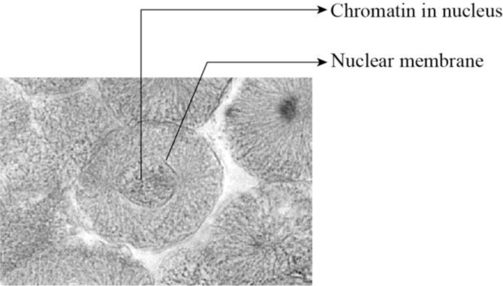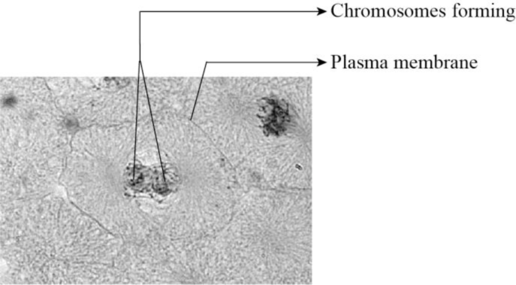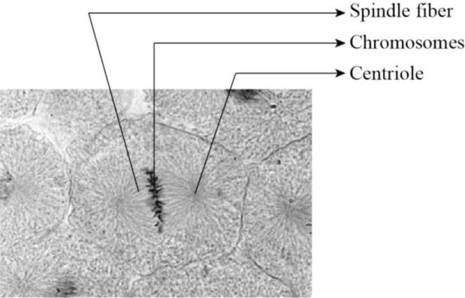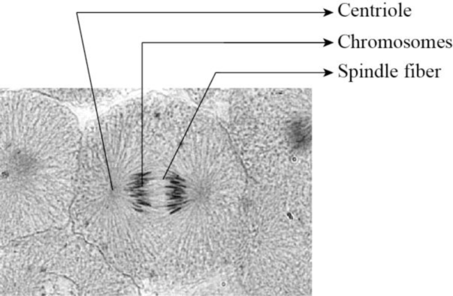
(a)
To identify: The interphase, each phase of mitosis and cytokinesis in the figure 4.4(a)-(e).
Introduction: The cell division is the process of cycle cycle in which the parent cell divided into two or more daughter cells. The cell divison is needed for growth of the individual, wound healing and replacement of old and dying cells. The duration of cell division differs on the type of the cell. The somatic cell divison consists of three phases namely interphase, mitotic phase and cytokinesis.
(a)
Answer to Problem 1.1BGL
Pictorial representation: The phase of cell cycle given in the figure 4.4 (a) is identified as interphase.

Fig 1: The interphase of somatic cell division.
Explanation of Solution
The interphase is the longest part of the cell cycle. During this phase the cell grow and replicates its DNA before moving into the mitosis. The interphase consist of three stages anmely G1 phase, S phase and G2 phase. The G1 phase is the first gap pahse in which the cell grows larger and organeeles are copied. The S phase is the synthetic phase in which the DNA of the cell replicates to produce another copy of DNA. The G2 phase is the second gap pahse in which the cells makes proteins and reorganise its contents before it enters into the mitosis.
(b)
To identify: The interphase, each phase of mitosis and cytokinesis in the figure 4.4(a)-(e).
Introduction: The cell division is the process of cycle cycle in which the parent cell divided into two or more daughter cells. The cell divison is needed for growth of the individual, wound healing and replacement of old and dying cells. The duration of cell division differs on the type of the cell. The somatic cell divison consists of three phases namely interphase, mitotic phase and cytokinesis.
(b)
Answer to Problem 1.1BGL
Pictorial representation: The phase of cell cycle given in the figure 4.4 (b) is identified as prophase.

Fig 2: The prophase of somatic cell division.
Explanation of Solution
The mitotic phase of the cell division is called as M phase. This phase consists of four stages namely prophase, metaphase, anaphase and telophase. The prophase is the first phase of cell division. During this phase, the chromosomes becomes visible, the nucleolus disappears, the chromatin condenses, the mitotic spindle forms and the nuclear envelope disappears.
(c)
To identify: The interphase, each phase of mitosis and cytokinesis in the figure 4.4(a)-(e).
Introduction: The cell division is the process of cycle cycle in which the parent cell divided into two or more daughter cells. The cell divison is needed for growth of the individual, wound healing and replacement of old and dying cells. The duration of cell division differs on the type of the cell. The somatic cell divison consists of three phases namely interphase, mitotic phase and cytokinesis.
(c)
Answer to Problem 1.1BGL
Pictorial representation: The phase of cell cycle given in the figure 4.4 (c) is identified as metaphase.

Fig 3: The metaphase of somatic cell division.
Explanation of Solution
The metaphase is the second phase of mitosis. At the start of metaphase the chromosomes are randomly arranged within the nucleus. The microtubules connects to each chromosome. Then the chromosomes are aligned in the middle of the cell with the sister chromatids of each chromosome on either side of the metaphase plate. The sister chromatids contains cohensin proteins which are broken after passing the mitotic check point to ensure alignment of chromosomes at the metaphase plate. This then acrtivates the anaphase-promoting complex which leads to end of metaphase.
(d)
To identify: The interphase, each phase of mitosis and cytokinesis in the figure 4.4(a)-(e).
Introduction: The cell division is the process of cycle cycle in which the parent cell divided into two or more daughter cells. The cell divison is needed for growth of the individual, wound healing and replacement of old and dying cells. The duration of cell division differs on the type of the cell. The somatic cell divison consists of three phases namely interphase, mitotic phase and cytokinesis.
(d)
Answer to Problem 1.1BGL
Pictorial representation: The phase of cell cycle given in the figure 4.4 (d) is identified as anaphase.

Fig 4: The anaphase of somatic cell division.
Explanation of Solution
The anaphase of cell cycle begins with the formation of anaphase promoting complex. This complex degrades the protein called securin which inhibits the separase. The separase is the protein that separates the cohesion protein that helds the chromatids together. As the result of this process the chromatids becomes apart from each other.
(e)
To identify: The interphase, each phase of mitosis and cytokinesis in the figure 4.4(a)-(e).
Introduction: The cell division is the process of cycle cycle in which the parent cell divided into two or more daughter cells. The cell divison is needed for growth of the individual, wound healing and replacement of old and dying cells. The duration of cell division differs on the type of the cell. The somatic cell divison consists of three phases namely interphase, mitotic phase and cytokinesis.
(e)
Answer to Problem 1.1BGL
Pictorial representation: The phase of cell cycle given in the figure 4.4 (e) is identified as telophase.

Fig 5: The telophase of somatic cell division.
Explanation of Solution
The telophase is the final stage of cell cycle. During this phase, the spindle fibers underoes depolymerisation that separstes the sister chromatids. The separate chromosomes are released from tighltly bound structure. Then the nuclear envelops reforms around the new nuclei in each half of the dividing cells.
Want to see more full solutions like this?
Chapter 4 Solutions
Laboratory Manual for Anatomy and Physiology, 6e Loose-Leaf Print Companion
 Human Anatomy & Physiology (11th Edition)BiologyISBN:9780134580999Author:Elaine N. Marieb, Katja N. HoehnPublisher:PEARSON
Human Anatomy & Physiology (11th Edition)BiologyISBN:9780134580999Author:Elaine N. Marieb, Katja N. HoehnPublisher:PEARSON Biology 2eBiologyISBN:9781947172517Author:Matthew Douglas, Jung Choi, Mary Ann ClarkPublisher:OpenStax
Biology 2eBiologyISBN:9781947172517Author:Matthew Douglas, Jung Choi, Mary Ann ClarkPublisher:OpenStax Anatomy & PhysiologyBiologyISBN:9781259398629Author:McKinley, Michael P., O'loughlin, Valerie Dean, Bidle, Theresa StouterPublisher:Mcgraw Hill Education,
Anatomy & PhysiologyBiologyISBN:9781259398629Author:McKinley, Michael P., O'loughlin, Valerie Dean, Bidle, Theresa StouterPublisher:Mcgraw Hill Education, Molecular Biology of the Cell (Sixth Edition)BiologyISBN:9780815344322Author:Bruce Alberts, Alexander D. Johnson, Julian Lewis, David Morgan, Martin Raff, Keith Roberts, Peter WalterPublisher:W. W. Norton & Company
Molecular Biology of the Cell (Sixth Edition)BiologyISBN:9780815344322Author:Bruce Alberts, Alexander D. Johnson, Julian Lewis, David Morgan, Martin Raff, Keith Roberts, Peter WalterPublisher:W. W. Norton & Company Laboratory Manual For Human Anatomy & PhysiologyBiologyISBN:9781260159363Author:Martin, Terry R., Prentice-craver, CynthiaPublisher:McGraw-Hill Publishing Co.
Laboratory Manual For Human Anatomy & PhysiologyBiologyISBN:9781260159363Author:Martin, Terry R., Prentice-craver, CynthiaPublisher:McGraw-Hill Publishing Co. Inquiry Into Life (16th Edition)BiologyISBN:9781260231700Author:Sylvia S. Mader, Michael WindelspechtPublisher:McGraw Hill Education
Inquiry Into Life (16th Edition)BiologyISBN:9781260231700Author:Sylvia S. Mader, Michael WindelspechtPublisher:McGraw Hill Education





